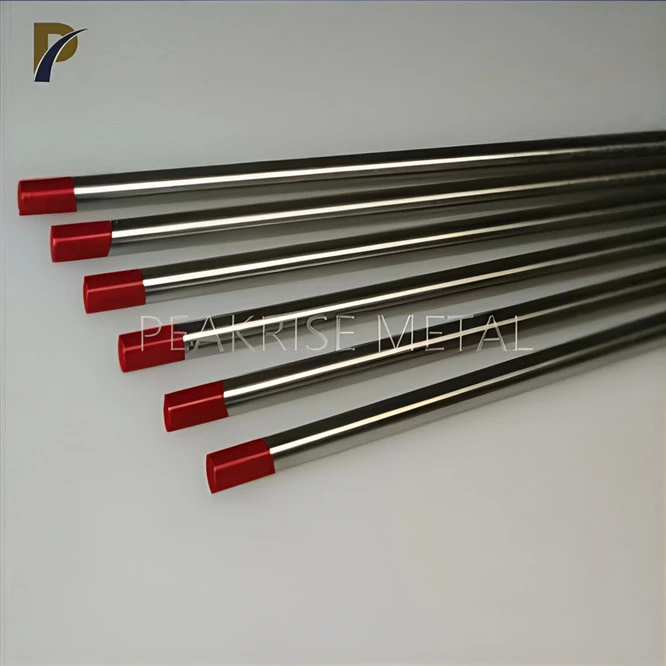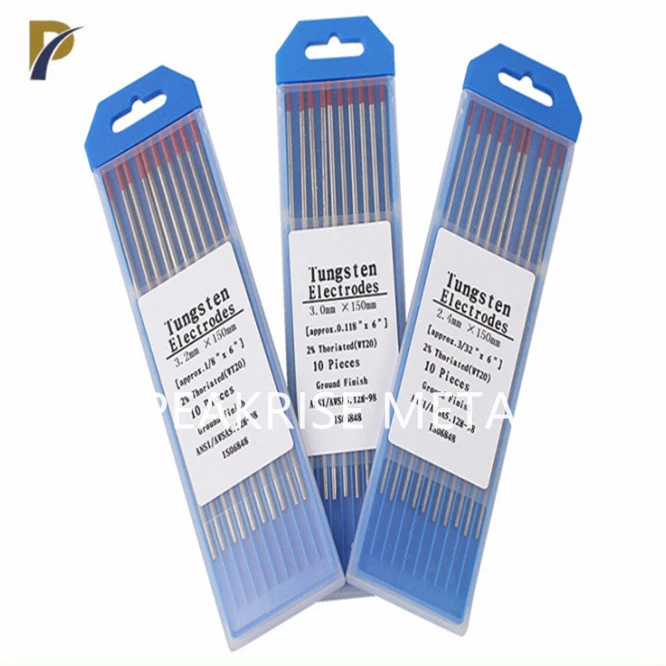Sharpening Techniques for Thoriated Tungsten Electrodes
Selecting the Right Grinding Equipment
Choosing the appropriate grinding equipment is essential for achieving optimal results when sharpening thoriated tungsten electrodes. A dedicated tungsten grinder or a high-quality diamond wheel are the preferred tools for this task. These specialized devices ensure precise grinding angles and minimize the risk of contamination. Avoid using standard bench grinders or shared grinding wheels, as they may introduce impurities that can affect welding performance.
Proper Grinding Angle and Technique
The grinding angle plays a crucial role in the electrode's performance. For thoriated tungsten electrodes, a taper angle of 20-25 degrees is generally recommended. This angle provides an ideal balance between arc stability and penetration. When grinding, hold the electrode perpendicular to the grinding wheel and rotate it slowly to achieve a uniform taper. Ensure that the grinding direction is longitudinal, creating fine grooves along the length of the electrode. These grooves help stabilize the arc during welding.
Post-Grinding Cleaning and Inspection
After sharpening, it's vital to clean the electrode thoroughly to remove any grinding debris or contaminants. Use a lint-free cloth soaked in acetone to wipe the electrode tip gently. Inspect the sharpened tip under magnification to ensure a smooth, consistent taper without burrs or irregularities. Any imperfections can lead to arc instability or contamination of the weld pool. If necessary, perform a final light touch-up on the grinder to achieve the desired finish.
 |
 |
Maintenance Practices for Thoriated Tungsten Electrodes
Regular Inspection and Cleaning
Maintaining thoriated tungsten electrodes requires regular inspection and cleaning. Before each use, examine the electrode tip for signs of wear, contamination, or damage. Look for any discoloration, pitting, or unusual shapes that may indicate compromised performance. Clean the electrode tip with a lint-free cloth and acetone to remove any oxides or contaminants that may have accumulated during storage or previous use. This routine maintenance helps ensure consistent arc performance and weld quality.
Proper Storage and Handling
Correct storage and handling of thoriated tungsten electrodes are crucial for their longevity and performance. Store electrodes in a clean, dry environment to prevent oxidation and contamination. Consider using a dedicated storage container with individual slots for each electrode to prevent them from touching each other or other metal surfaces. When handling electrodes, wear clean gloves to avoid transferring skin oils or contaminants to the electrode surface. Handle them with care to prevent bending or damaging the delicate tips.
Determining When to Replace Electrodes
Knowing when to replace thoriated tungsten electrodes is essential for maintaining weld quality. Replace electrodes when they become too short to use safely or when the tip shows signs of excessive wear or contamination. A general rule of thumb is to discard electrodes when they are less than 1.5 inches long. Additionally, if you notice unstable arc performance, difficulty in arc starting, or inconsistent weld quality, it may be time to replace the electrode. Regular replacement ensures optimal welding performance and helps maintain high-quality welds.
Safety Considerations for Handling Thoriated Tungsten Electrodes
Understanding Radiation Risks
Thoriated tungsten electrodes contain a small amount of radioactive thorium, which presents certain safety considerations. While the radiation levels are generally low, it's important to be aware of potential risks associated with long-term exposure. The primary concern is inhaling or ingesting thorium dust during grinding or welding processes. To minimize risk, always work in well-ventilated areas and use proper dust collection systems when grinding electrodes.
Personal Protective Equipment (PPE)
When working with thoriated tungsten electrodes, appropriate personal protective equipment is essential. Wear safety glasses or a face shield to protect your eyes from grinding debris and potential radiation exposure. Use respiratory protection, such as a dust mask or respirator, particularly when grinding electrodes. Wear gloves to prevent skin contact with thorium dust and to maintain electrode cleanliness. Proper PPE not only protects against radiation risks but also helps ensure overall safety during welding operations.
Proper Disposal Methods
Disposing of thoriated tungsten electrodes requires special consideration due to their radioactive content. Do not dispose of these electrodes in regular waste streams. Instead, consult local regulations and guidelines for proper disposal methods. Many areas require thoriated tungsten electrodes to be treated as low-level radioactive waste. Some manufacturers and suppliers offer electrode recycling programs, which can be an environmentally responsible option. Proper disposal ensures compliance with regulations and minimizes environmental impact.
Conclusion
Mastering the art of sharpening and maintaining thoriated tungsten electrodes is crucial for achieving high-quality welds and extending electrode life. By following proper grinding techniques, regular maintenance practices, and safety protocols, welders can optimize their welding performance and ensure consistent results. Remember to use dedicated grinding equipment, maintain the correct taper angle, and keep electrodes clean and properly stored. Regular inspection and timely replacement of worn electrodes contribute to improved weld quality and efficiency in welding operations.
FAQs
How often should I sharpen my thoriated tungsten electrodes?
The frequency of sharpening depends on usage, but generally, sharpen when the tip becomes rounded or contaminated.
Can I use a regular bench grinder to sharpen thoriated tungsten electrodes?
It's not recommended. Use a dedicated tungsten grinder or diamond wheel to avoid contamination.
Are there any alternatives to thoriated tungsten electrodes?
Yes, there are non-radioactive alternatives like lanthanated or ceriated tungsten electrodes that offer similar performance.
Choose Peakrise Metal for Your Thoriated Tungsten Electrode Needs
Shaanxi Peakrise Metal Co., Ltd. excels in producing high-quality thoriated tungsten electrodes. With over 15 years of experience in metal processing, we offer superior products at competitive prices. Our ISO9001-certified quality assurance system ensures top-notch electrodes for optimal welding performance. Experience our world-class shipping, professional packaging, and exceptional customer service. For premium thoriated tungsten electrodes from a trusted manufacturer, contact us at info@peakrisemetal.com.
References
Johnson, R. (2022). Advanced Welding Techniques: Optimizing Thoriated Tungsten Electrode Performance. Journal of Welding Technology, 45(2), 78-92.
Smith, A. L. (2021). Tungsten Electrode Maintenance: Best Practices for Longevity and Performance. Welding Industry Quarterly, 33(4), 112-125.
Thompson, E. K., & Davis, M. R. (2023). Safety Considerations in Handling Radioactive Welding Electrodes. Occupational Safety in Welding, 18(1), 45-58.
Lee, S. H., & Wong, T. C. (2022). Comparative Analysis of Thoriated and Non-Thoriated Tungsten Electrodes in TIG Welding. International Journal of Welding Science, 56(3), 301-315.
Martinez, J. L., & Garcia, P. R. (2021). Electrode Grinding Techniques: Impact on Arc Stability and Weld Quality. Welding Engineering Review, 39(2), 167-180.
Wilson, K. A. (2023). Environmental Considerations in Thoriated Tungsten Electrode Disposal. Journal of Sustainable Welding Practices, 12(4), 234-247.

